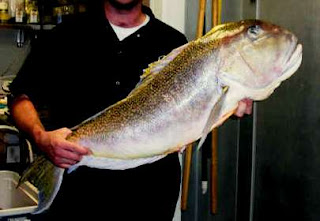
View from inside Reef's Wine Cellar into the dining room
I’m sure you’ve noticed that there are virtually no basements in Houston; being just 40 feet above sea level ensures that there are very few. So many of our beloved foods and beverages are created, aged and thrive in that zone of 55°-57° Fahrenheit with 60% relative humidity: red and white wine, beer, all forms of sausages, hams and charcuterie, cheeses and vinegar. This combination of the right temperature and humidity provides the optimal sweet spot for these items to properly age and mature until the time comes for you to reach that final objective, consumption. To re-create this ideal environment above ground calls for a little creativity. It is surprisingly simple to convert an old refrigerator into a “cellar;” all you need is an external thermostat, a hemostat and a small, inexpensive humidifier from Target. I just made one from a very old prep cooler to store our wines at Little Bigs Montrose. The light blue control pad with the temperature reading sits right next to the cashier. This particular unit is pretty damn amazing. You can set it at temperature variables between X and Y and, within those variables select run times so that your compressor won’t overwork itself by repeatedly kicking itself on and off too quickly. You might be asking yourself why we would need to maintain cellar temp wines in a burger joint. And I say, WTF not? I get a kick out of it and if you’re gonna be a bear, be a grizzly!

Remote Temperature Control at Little Bigs Montrose
All the equipment you need can easily be picked up at a place called Allied Kenco. If you are even just slightly obsessed with charcuterie, this place is a mandatory stop. Cody is the man to see over there and, for the past five years, he has helped satisfy my fixation for these types of things.
Luckily, at Reef, there is no need to convert old kitchen equipment since I already have a real “cellar.”

Remote Temperature Control at Little Bigs Montrose
All the equipment you need can easily be picked up at a place called Allied Kenco. If you are even just slightly obsessed with charcuterie, this place is a mandatory stop. Cody is the man to see over there and, for the past five years, he has helped satisfy my fixation for these types of things.
Luckily, at Reef, there is no need to convert old kitchen equipment since I already have a real “cellar.”
Since Reef opened, I have been jones-ing to use this room for something other than wine. But hanging whole joints of meat next to my beloved Innocent Bystander (all the while staring into the eyes of a starry-eyed young couple enjoying a romantic dinner at Table 4) is just not an option. So, I’ve been waiting for just the right opportunity to age something in full view of the dining room.
We have been making our own pepper vinegar at Reef since day one, using it in vinaigrettes, pickling liquids and finishing sauces. You will always see a bottle of it right next to me up at the expediting “pass.” We use a fresh Thai pepper called a Dragon Finger (aka Harlingen Red).

Dragon Finger Chilis
I have always thought, “If I could just get my hands on an Oak barrel to age this vinegar... .” Well, look what showed up on our doorstep.

Oak barrel brought to us by our good friends at Quintessa Winery
As we speak, I’ve got a guy building a cradle to hold the barrel so we can store it at the end of the wine room.
A local farmer who grows for us -- Stacey Roussel from All We Need Organics – has done a great job growing these peppers. Once she hits the generous glut of the season, we are going to fire that sucker up and see where we’re at.
I’ll let you know how our aged pepper vinegar turns out in 2010.
We have been making our own pepper vinegar at Reef since day one, using it in vinaigrettes, pickling liquids and finishing sauces. You will always see a bottle of it right next to me up at the expediting “pass.” We use a fresh Thai pepper called a Dragon Finger (aka Harlingen Red).

Dragon Finger Chilis
I have always thought, “If I could just get my hands on an Oak barrel to age this vinegar... .” Well, look what showed up on our doorstep.

Oak barrel brought to us by our good friends at Quintessa Winery
As we speak, I’ve got a guy building a cradle to hold the barrel so we can store it at the end of the wine room.
A local farmer who grows for us -- Stacey Roussel from All We Need Organics – has done a great job growing these peppers. Once she hits the generous glut of the season, we are going to fire that sucker up and see where we’re at.
I’ll let you know how our aged pepper vinegar turns out in 2010.























